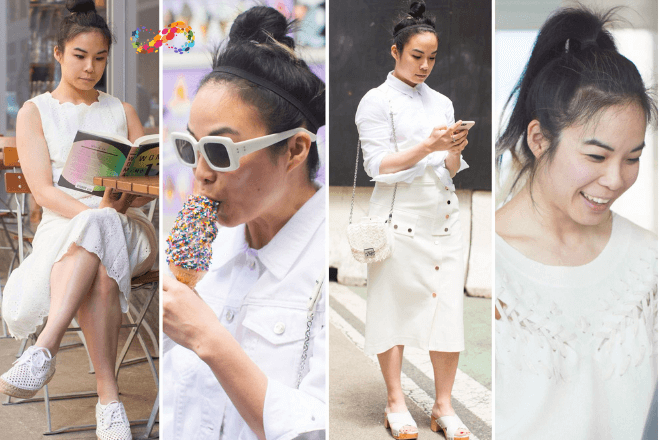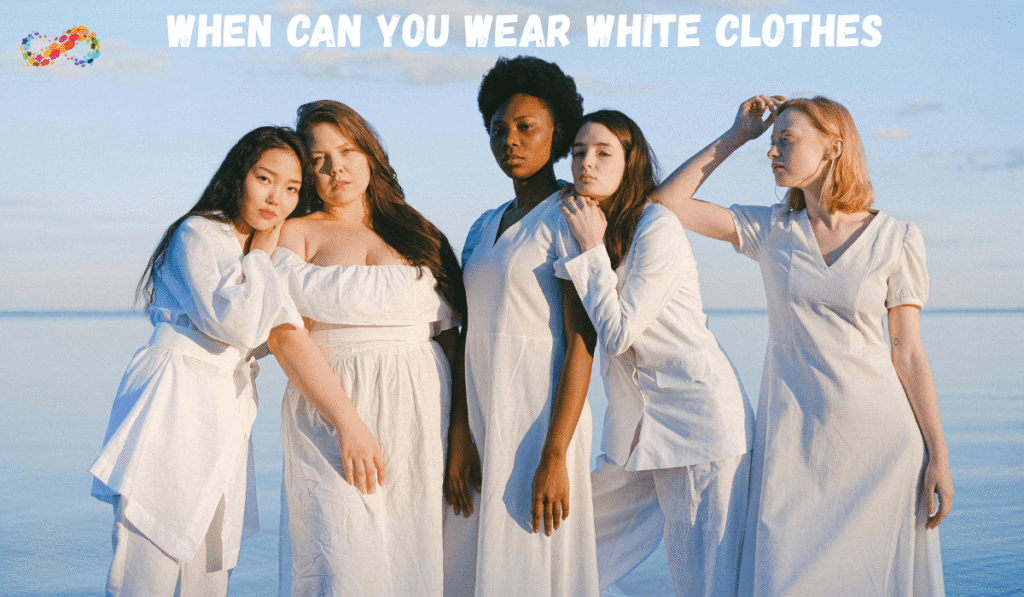I can still picture that September afternoon, standing in front of my closet, my fingers brushing against a crisp white blouse that felt like summer bottled up in fabric. My grandmother’s voice echoed in my head: “You can’t wear white after Labor Day, dear.” I was a teenager, half-amused, half-puzzled by this rule I’d never questioned. Why was this color, so bright and hopeful, bound by such a rigid timeline? That moment sparked a curiosity that’s stayed with me—about the traditions, myths, and sheer joy of wearing white. It’s not just about when you can wear white clothes; it’s about what white means, how it makes you feel, and why it’s become a symbol of freedom in modern fashion.
Let’s dive into the world of white clothing, from its old-school etiquette to its cultural significance, debunking myths like “does white make you look bigger?” and celebrating the timeless allure of a color that carries so much meaning. Whether you’re eyeing a white skirt for winter or an all-white outfit for a New Year’s Eve bash, this is about finding your own rules.
The Roots of the “No White After Labor Day” Rule
Back in the early 20th century, wearing white was a status symbol. The wealthy elite donned pristine linens and cotton dresses during their summer escapes to the Hamptons or the countryside, where white stayed clean and cool. Come Labor Day, the unofficial end of summer, they swapped their airy whites for darker, “serious” hues to signal their return to city life. This wasn’t just about seasons—it was about belonging. Wearing white after Labor Day marked you as out of touch, someone who didn’t know the unspoken code.
I think of my grandmother, raised in a small town where these rules were as sacred as Sunday dinners. She’d tell me stories of women who wouldn’t dream of wearing white shoes in October, as if it were a moral failing. But those rules were born in a different time, one where class and conformity shaped wardrobes. Today, they feel like relics, charming but not binding.
White Across Cultures and Occasions

White isn’t just a color—it’s a symbol, carrying meanings of purity, renewal, and fresh starts across cultures and moments. These traditions shape when we choose to wear white, each with its own emotional resonance.
Weddings: In Western culture, the bride’s white gown is iconic, a symbol of purity and new beginnings. As a guest, wearing white to a wedding is a no-go unless the couple calls for a “white party attire” vibe. I once attended a beach wedding where everyone was asked to wear white. The sight of flowing dresses and linen suits against the sunset felt like a scene from a dream, unified and serene.
Easter: White on Easter feels like wearing spring itself. A white dress or children’s white pants reflect the season’s themes of renewal and hope. I remember slipping into a white sundress for an Easter brunch, feeling like I was channeling the bloom of the season, even if I had to dodge a rogue mimosa spill.
Memorial Day and Labor Day: In the U.S., Memorial Day often marks the “start” of white-wearing season, while Labor Day signals its end. But these boundaries are fading. I’ve seen women rock winter white tops or tailored white pants in February, proving white isn’t just for summer anymore.
New Year’s Eve: In places like Brazil, wearing white on New Year’s Eve is a tradition to attract good luck. I tried it once, wearing a white dress to a rooftop party, and there was something exhilarating about starting the year in a color that felt like a clean slate.
These moments show that wearing white is about more than fashion—it’s about marking milestones, embracing meaning, and feeling connected to something bigger.
Seasonal Style: Wearing White Year-Round
The old rules pegged white as a summer-only color, but modern fashion has torn up that playbook. Here’s how white works in every season, proving there’s no wrong time to wear it.
Spring: White feels like it was made for spring. A white cotton dress or a pair of white pants outfits for women screams fresh starts. I wore a white skirt to a spring picnic once, and despite a close call with some berry juice, it felt like the perfect choice—light, hopeful, alive.
Summer: This is white’s classic season. All-white outfits, from casual linen shirts to elegant dresses, are summer staples. Picture a white on white outfit for a beach barbecue or an all-white cowboy outfit for a festival. It’s effortless and cool, in every sense.
Fall: Can you wear white in fall? You bet. Think creamy sweaters, white jeans with a rust-colored coat, or a white skirt in heavier fabrics like wool. I hesitated to wear white pants in October once, worried I’d look out of season, but paired with a chunky sweater, they felt perfectly autumnal.
Winter: Winter white fashion is pure magic. A winter white top or a plush white coat against a snowy backdrop is stunning. I’ve seen women in all-white outfits at winter galas, looking like they stepped out of a fairy tale. The key is texture—cashmere, wool, or soft white clothing that feels warm and inviting.
The beauty of today’s fashion is its freedom. You can wear white pants now, in March, or even after Labor Day. A white chic attire moment—like a white fashion jacket over a white dress—works just as well in January as it does in July.
Debunking the Myth: Does White Make You Look Fat?
One of the biggest myths about white clothing is that it makes you look bigger, fatter, or less flattering. I’ve had those moments, staring at a white top in the mirror, wondering if it would highlight every insecurity. But here’s the truth: it’s not about the color—it’s about the fit. White reflects light, sure, but so do pastels or metallics. A well-cut white dress or tailored white pants can be as slimming as black.
I remember a friend who swore off white for years, convinced it would make her look “too big.” Then she tried a fitted white blazer over a black dress, and it was like she’d found a new superpower. White doesn’t make you look bigger—it makes you look bold. If you’re nervous, play with proportions: a flowy white top with slim jeans or a structured white skirt with a tucked-in blouse. And let’s be honest—questions like “why do I look fat in white?” are more about our inner critic than the clothes themselves. Wear what makes you feel like you, and white will work its magic.
Modern Fashion Freedom: No Rules, Just Confidence
Today, the answer to “when is it acceptable to wear white?” is simple: whenever you feel like it. Fashion has become a celebration of individuality, and white is no longer confined by outdated rules. Celebrities like LisaRaye McCoy, who’s known for wearing white all the time, embody this freedom. Why does LisaRaye always wear white? For her, it’s a signature—a way to stand out and radiate clarity. I admire that kind of commitment, even if I’m not ready to go full white-on-white every day.
On platforms like X, you’ll see people embracing white year-round, from classy all-white outfits for couples to casual white tops from Amazon paired with denim. You can wear white in April, in winter, or to a winter white party. The only rule is to wear it with purpose. A white fashion moment—say, an off-white outfit for women or an elegant white attire for a special event—feels like a statement of confidence.
Traditional Rules vs. Modern Attitudes: A Side-by-Side Look
| Aspect | Traditional Rules | Modern Attitudes |
|---|---|---|
| When to Wear White | Only between Memorial Day and Labor Day | Any time, any season |
| Occasions | Weddings (for brides), summer events | Casual, formal, or cultural events |
| Fabrics | Light linens, cottons for summer only | Wool, cashmere, denim—year-round versatility |
| Perception | White is elite, seasonal, impractical | White is bold, timeless, accessible |
| Body Image Myths | White makes you look bigger | Fit and confidence outweigh color concerns |
| Cultural Symbolism | Purity, summer exclusivity | Renewal, personal expression, fresh starts |
| Fashion Freedom | Strict etiquette, social conformity | Wear what feels right, no boundaries |
The Emotional Power of Wearing White
There’s something almost ceremonial about slipping into white. It’s like stepping into a fresh start, whether it’s a white dress for a big day or a white shirt for a regular Tuesday. I’ve worn white on days when I needed a boost—like after a rough week or before a nerve-wracking presentation. It’s not just about looking good; it’s about feeling renewed. Wearing all white, whether for a white party dress code or just because, has a quiet strength. It says, “I’m here, and I’m not afraid to be seen.”
I sometimes wonder why white feels so special. Is it the way it catches light, making you glow? Or the psychology of wearing white clothes—studies suggest light colors can lift your mood and signal openness. Whatever it is, white has a way of making you feel like you’re carrying a little piece of possibility.
Why White Never Goes Out of Style
White isn’t just a trend—it’s eternal. From ancient priests in white robes to today’s minimalist chic, white has always adapted, always endured. It’s the color of first communions, summer sails, and New Year’s resolutions. It’s what you wear when you want to feel new, whether it’s Easter, a wedding, or a random morning when you need a reset. The question “when can you wear white clothes?” isn’t about calendars—it’s about moments when you want to feel bold, clean, or free.
I think back to that white blouse I almost didn’t wear after Labor Day. I wore it anyway, and it felt like a tiny rebellion, a nod to my own rules. White isn’t just a color; it’s a mindset. Wear it whenever your heart says yes.
See More Dress to Win: Your Guide to Women’s Interview Outfits for 2024
Your White Wardrobe Questions, Answered
Q: When can you wear white clothes?
Anytime! The old Memorial Day to Labor Day rule is history. From winter white apparel to summer dresses, style it for the season.
Q: Can you wear white pants after Labor Day?
Yes! White pants in fall or winter, like wool or denim, look stunning with sweaters or coats. It’s all about the right texture.
Q: Does white make you look bigger?
Not if the fit is right. Tailored white clothes, like a blazer or fitted pants, are as flattering as any color. Confidence is key.
Q: What does wearing white symbolize?
White stands for purity, renewal, and fresh starts. It’s why it’s worn for weddings, Easter, or New Year’s Eve in some cultures.
Q: Can you wear white in winter?
Definitely! Winter white fashion, like cashmere sweaters or creamy coats, is elegant and cozy. Pair with boots for a chic look.
Q: Is it okay to wear white to a wedding?
Unless it’s a white party attire event, skip white to avoid stealing the bride’s spotlight. Check with the couple if unsure.
Q: What are the modern rules for wearing white?
There are none! Wear white whenever it feels right—casual, formal, summer, or winter. Just keep it clean and styled.
Q: Why does LisaRaye always wear white?
LisaRaye McCoy uses white as her signature, symbolizing clarity and confidence. It’s a personal style choice that defines her.
Q: Can you wear white on New Year’s Eve?
Yes! In many cultures, white on New Year’s Eve brings good luck. Try an all-white classy outfit for a fresh start.
Q: When should you start wearing white pants?
Whenever you want! Spring and summer are classic, but white pants in fall or winter with cozy layers are just as stylish.


Pingback: Best Dresses for Pear Shaped Body: Flatter Your Curves